- Accueil
- À propos de nous
- Industrie
- Services
- Lecture
- Contactez-nous
Marché de la gestion des risques liés aux tiers : Analyse actuelle et prévisions (2024-2032)
Accent mis sur le composant (solutions et services) ; l’organisation (PME et grandes entreprises) ; le mode de déploiement (cloud et sur site) ; l’utilisateur final (IT & Telecom, BFSI, santé, commerce de détail, industrie manufacturière, énergie et services publics) ; et la région/le pays
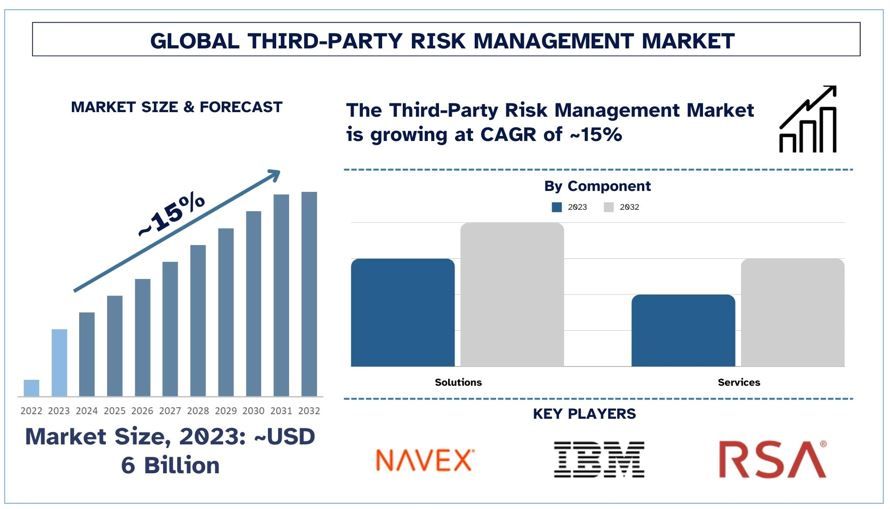 Taille et prévisions du marché mondial de la gestion des risques liés aux tiers
Taille et prévisions du marché mondial de la gestion des risques liés aux tiers
Le marché mondial de la gestion des risques liés aux tiers était évalué à environ 6 milliards de dollars US en 2023 et devrait croître à un TCAC solide d'environ 15 % au cours de la période de prévision (2024-2032) en raison des lourdes amendes et pénalités pour non-conformité, ce qui incite les organisations à adopter des solutions efficaces de gestion des risques.
Analyse du marché mondial de la gestion des risques liés aux tiers
Le marché de la gestion des risques liés aux tiers comprend les produits, les applications et les services qui aident les organisations à évaluer et à gérer les risques liés aux parties prenantes tierces, telles que les fournisseurs, les prestataires et les partenaires. Le marché est alimenté par des facteurs tels que la mondialisation et l'acquisition et l'externalisation croissantes, l'incidence croissante des cybercrimes, les exigences réglementaires étendues et l'évolution de la compréhension des menaces tierces. Les grandes et moyennes entreprises investissent dans des programmes robustes de gestion des risques liés aux tiers afin d'améliorer la posture de gestion des risques de l'organisation, de répondre aux exigences réglementaires et de projeter une image positive de leurs opérations. Dans le contexte actuel, où les entreprises ressentent un besoin croissant de fournisseurs tiers et de représentants de la chaîne d'approvisionnement élargie des entreprises, le marché des outils de gestion des risques liés aux tiers continuera également de croître.
Tendances du marché mondial de la gestion des risques liés aux tiers
Cette section traite des principales tendances du marché qui influencent les différents segments du marché mondial de la gestion des risques liés aux tiers, telles qu'identifiées par notre équipe d'experts en recherche.
Le segment sur site transforme l'industrie
La catégorie sur site stimule le marché de la gestion des risques liés aux tiers en offrant aux organisations un meilleur contrôle sur leurs données et leurs protocoles de sécurité. Cette approche permet aux entreprises de gérer et d'atténuer les risques associés aux fournisseurs tiers au sein de leur infrastructure, en garantissant la conformité aux exigences réglementaires et en améliorant la confidentialité des données. Les solutions sur site offrent des cadres de gestion des risques personnalisables, adaptés aux besoins spécifiques de l'organisation, ce qui entraîne une adoption accrue dans les secteurs soumis à des mandats stricts de protection des données, tels que la finance et la santé.
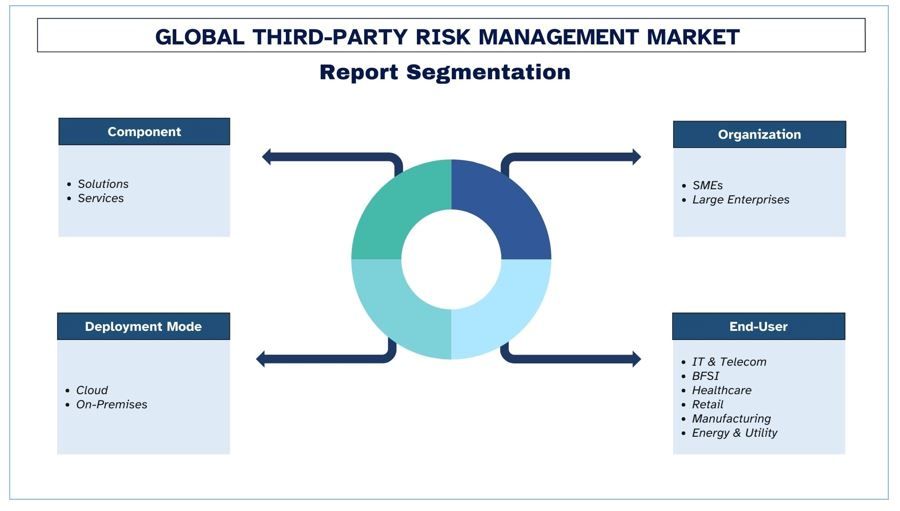
La région Asie-Pacifique devrait croître au TCAC le plus rapide au cours de la période de prévision.
Le marché de la gestion des risques liés aux tiers (Third-Party Risk Management - TPRM) s'est imposé comme une branche prometteuse du marché plus vaste de la gestion des risques dans la région Asie-Pacifique en raison de la tendance croissante de la région à l'externalisation et aux collaborations avec des tiers. La TPRM est le processus d'évaluation, de gestion et de contrôle des risques liés aux tiers afin de prévenir ou de minimiser leur non-conformité, leurs menaces et leur volatilité pour l'entreprise. Sur ce marché, les moteurs de croissance sont un taux croissant de cybermenaces, les besoins de conformité et une chaîne d'approvisionnement croissante. En outre, l'adoption de stratégies de transformation numérique dans divers secteurs et la nécessité de protocoles complets d'évaluation des risques font progresser le marché. En ce qui concerne les tendances du secteur, les solutions avancées de TPRM suscitent davantage d'attention parmi les entreprises de la région Asie-Pacifique en ce qui concerne leur gestion des risques afin de protéger leur activité.
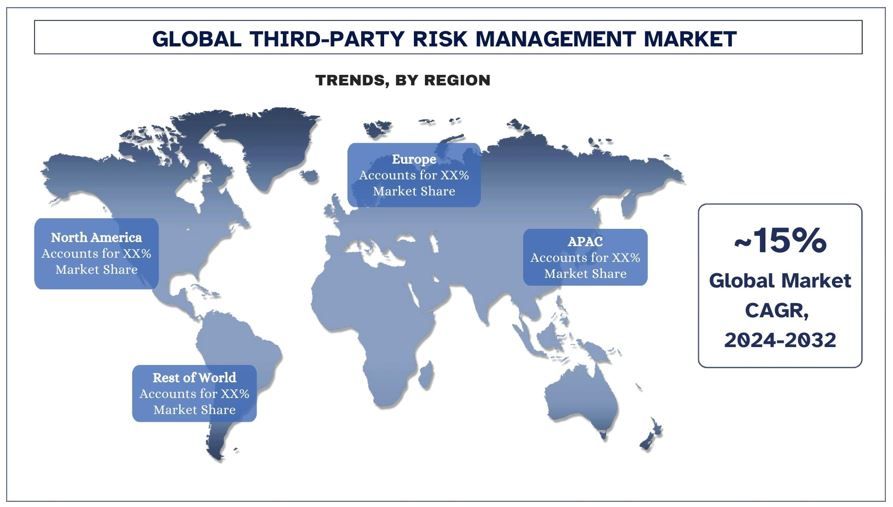
Aperçu du secteur mondial de la gestion des risques liés aux tiers
Le marché mondial de la gestion des risques liés aux tiers est concurrentiel, avec plusieurs acteurs mondiaux et internationaux. Les principaux acteurs adoptent différentes stratégies de croissance pour renforcer leur présence sur le marché, telles que les partenariats, les accords, les collaborations, les lancements de nouveaux produits, les expansions géographiques, les fusions et acquisitions. Parmi les principaux acteurs opérant sur le marché figurent PwC ; KPMG International ; ServiceNow ; Deloitte ; Genpact ; BitSight Technologies, Inc. ; NAVEX Global, Inc. ; EY ; IBM ; RSA Security LLC
Couverture du rapport sur le marché mondial de la gestion des risques liés aux tiers
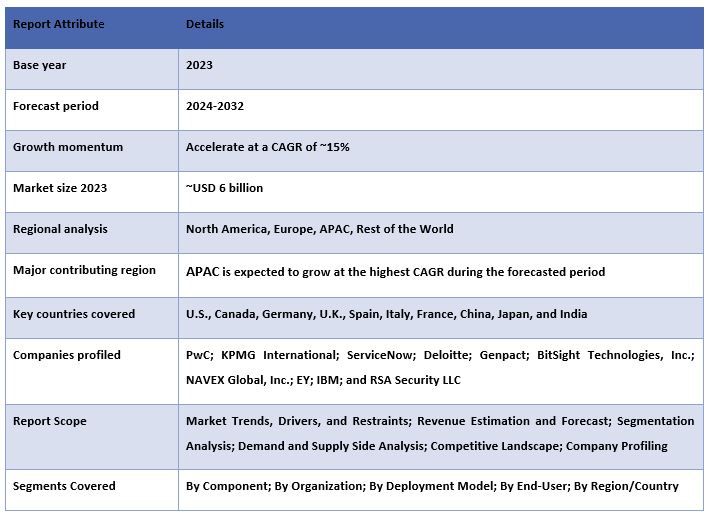
Raisons d'acheter ce rapport :
- L'étude comprend une analyse de la taille et des prévisions du marché, validée par des experts clés authentifiés du secteur.
- Le rapport passe brièvement en revue la performance globale de l'industrie en un coup d'œil.
- Le rapport couvre une analyse approfondie des principaux acteurs du secteur, en mettant l'accent sur les principales données financières de l'entreprise, les portefeuilles de types, les stratégies d'expansion et les développements récents.
- Examen détaillé des moteurs, des contraintes, des principales tendances et des opportunités qui prévalent dans l'industrie.
- L'étude couvre de manière exhaustive le marché à travers différents segments.
- Analyse approfondie au niveau régional de l'industrie.
Options de personnalisation :
Le marché mondial de la gestion des risques liés aux tiers peut être personnalisé davantage en fonction des besoins ou de tout autre segment de marché. En outre, UMI comprend que vous pouvez avoir vos propres besoins commerciaux, n'hésitez donc pas à nous contacter pour obtenir un rapport qui corresponde parfaitement à vos exigences.
Table des matières
Méthodologie de recherche pour l'analyse du marché mondial de la gestion des risques tiers (2024-2032)
L'analyse du marché historique, l'estimation du marché actuel et la prévision du marché futur du marché mondial de la gestion des risques tiers ont été les trois principales étapes entreprises pour créer et analyser l'adoption de la gestion mondiale des risques tiers dans les principales régions. Une recherche secondaire exhaustive a été menée pour collecter les chiffres du marché historique et estimer la taille actuelle du marché. Deuxièmement, pour valider ces informations, de nombreuses conclusions et hypothèses ont été prises en compte. De plus, des entretiens primaires exhaustifs ont été menés avec des experts de l'industrie à travers la chaîne de valeur du marché mondial de la gestion des risques tiers. Pour l'hypothèse et la validation des chiffres du marché par le biais d'entretiens primaires, nous avons utilisé une approche descendante/ascendante pour prévoir la taille complète du marché. Par la suite, des méthodes de ventilation du marché et de triangulation des données ont été adoptées pour estimer et analyser la taille du marché des segments et sous-segments de l'industrie concernée. La méthodologie détaillée est expliquée ci-dessous :
Analyse de la taille du marché historique
Étape 1 : Étude approfondie des sources secondaires :
Une étude secondaire détaillée a été menée pour obtenir la taille du marché historique du marché mondial de la gestion des risques tiers grâce à des sources internes à l'entreprise telles que les rapports annuels et les états financiers, les présentations de performances, les communiqués de presse, etc., et des sources externes, notamment des revues, des actualités et des articles, des publications gouvernementales, des publications de concurrents, des rapports sectoriels, une base de données tierce et d'autres publications crédibles.
Étape 2 : Segmentation du marché :
Après avoir obtenu la taille du marché historique du marché mondial de la gestion des risques tiers, nous avons mené une analyse secondaire détaillée pour recueillir des informations sur le marché historique et les parts des différents segments et sous-segments pour les principales régions. Les principaux segments inclus dans le rapport sont les composants, l'organisation, le mode de déploiement, l'utilisateur final et les régions. Des analyses plus poussées au niveau des pays ont été menées pour évaluer l'adoption globale des modèles de test dans cette région.
Étape 3 : Analyse des facteurs :
Après avoir acquis la taille du marché historique des différents segments et sous-segments, nous avons mené une analyse détaillée des facteurs pour estimer la taille actuelle du marché mondial de la gestion des risques tiers. De plus, nous avons mené une analyse des facteurs à l'aide de variables dépendantes et indépendantes telles que les composants, l'organisation, le mode de déploiement, l'utilisateur final et les régions du marché mondial de la gestion des risques tiers. Une analyse approfondie des scénarios de l'offre et de la demande a été menée en tenant compte des principaux partenariats, fusions et acquisitions, de l'expansion commerciale et des lancements de produits sur le marché mondial de la gestion des risques tiers.
Estimation et prévision de la taille actuelle du marché
Détermination de la taille actuelle du marché : sur la base des informations exploitables tirées des 3 étapes ci-dessus, nous sommes parvenus à la taille actuelle du marché, aux principaux acteurs du marché mondial de la gestion des risques tiers et aux parts de marché des segments. Tous les pourcentages de parts requis et les ventilations du marché ont été déterminés à l'aide de l'approche secondaire susmentionnée et ont été vérifiés par le biais d'entretiens primaires.
Estimation et prévision : pour l'estimation et la prévision du marché, des pondérations ont été attribuées à plusieurs facteurs, notamment les moteurs et les tendances, les contraintes et les opportunités disponibles pour les parties prenantes. Après avoir analysé ces facteurs, les techniques de prévision pertinentes, c'est-à-dire l'approche descendante/ascendante, ont été appliquées pour parvenir à la prévision du marché 2032 pour différents segments et sous-segments sur les principaux marchés mondiaux. La méthodologie de recherche adoptée pour estimer la taille du marché comprend :
- La taille du marché de l'industrie, en termes de revenus (USD) et le taux d'adoption du marché mondial de la gestion des risques tiers sur les principaux marchés nationaux
- Tous les pourcentages de parts, les divisions et les ventilations des segments et sous-segments de marché
- Principaux acteurs du marché mondial de la gestion des risques tiers en termes de types offerts. Également, les stratégies de croissance adoptées par ces acteurs pour concurrencer sur le marché en croissance rapide.
Validation de la taille et des parts du marché
Recherche primaire : des entretiens approfondis ont été menés avec les principaux leaders d'opinion (KOL), y compris les cadres supérieurs (CXO/VP, chef des ventes, chef du marketing, chef des opérations, chef régional, chef de pays, etc.) dans les principales régions. Les résultats de la recherche primaire ont ensuite été résumés, et une analyse statistique a été effectuée pour prouver l'hypothèse énoncée. Les informations issues de la recherche primaire ont été consolidées avec les résultats secondaires, transformant ainsi l'information en informations exploitables.
Répartition des participants primaires dans différentes régions
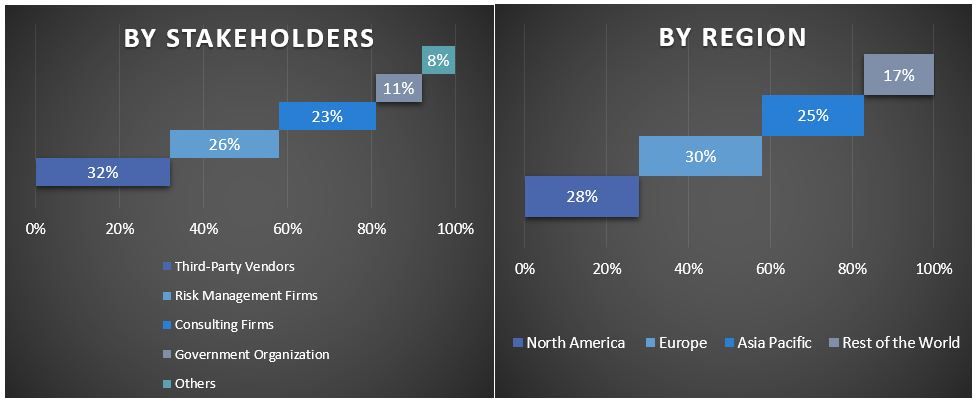
Ingénierie du marché
La technique de triangulation des données a été utilisée pour compléter l'estimation globale du marché et pour parvenir à des chiffres statistiques précis pour chaque segment et sous-segment du marché mondial de la gestion des risques tiers. Les données ont été divisées en plusieurs segments et sous-segments après avoir étudié divers paramètres et tendances dans les composants, l'organisation, le mode de déploiement, l'utilisateur final et les régions du marché mondial de la gestion des risques tiers.
L'objectif principal de l'étude du marché mondial de la gestion des risques tiers
Les tendances actuelles et futures du marché mondial de la gestion des risques tiers ont été mises en évidence dans l'étude. Les investisseurs peuvent obtenir des informations stratégiques pour fonder leur discrétion en matière d'investissements sur l'analyse qualitative et quantitative effectuée dans l'étude. Les tendances actuelles et futures du marché ont déterminé l'attractivité globale du marché au niveau régional, offrant une plateforme au participant industriel pour exploiter le marché inexploité afin de bénéficier d'un avantage de premier entrant. Les autres objectifs quantitatifs des études comprennent :
- Analyser la taille actuelle et prévisionnelle du marché mondial de la gestion des risques tiers en termes de valeur (USD). Analyser également la taille actuelle et prévisionnelle du marché des différents segments et sous-segments.
- Les segments de l'étude comprennent les domaines des composants, de l'organisation, du mode de déploiement, de l'utilisateur final et des régions.
- Définir et analyser le cadre réglementaire de l'industrie.
- Analyser la chaîne de valeur impliquée avec la présence de divers intermédiaires, ainsi qu'analyser les comportements des clients et des concurrents de l'industrie.
- Analyser la taille actuelle et prévisionnelle du marché mondial de la gestion des risques tiers pour les principales régions.
- Les principaux pays des régions étudiées dans le rapport comprennent l'Asie-Pacifique, l'Europe, l'Amérique du Nord et le reste du monde.
- Profils d'entreprise du marché mondial de la gestion des risques tiers et stratégies de croissance que les acteurs adoptent pour se maintenir sur le marché en croissance rapide.
- Analyse approfondie au niveau régional de l'industrie
Questions Fréquemment Posées FAQ
Q1 : Quelle est la taille actuelle du marché mondial de la gestion des risques liés aux tiers et son potentiel de croissance ?
Q2 : Quels sont les principaux facteurs de croissance du marché mondial de la gestion des risques liés aux tiers ?
Q3 : Quel segment détient la plus grande part du marché mondial de la gestion des risques tiers par catégorie de composant ?
Q4 : Quelles sont les technologies émergentes et les tendances du marché mondial de la gestion des risques liés aux tiers ?
Q5 : Quelle région dominera le marché mondial de la gestion des risques tiers ?
Connexes Rapports
Les clients qui ont acheté cet article ont également acheté










